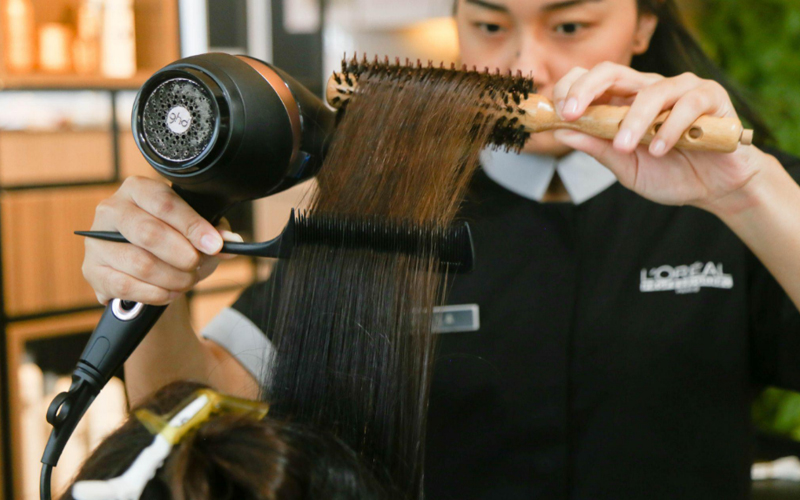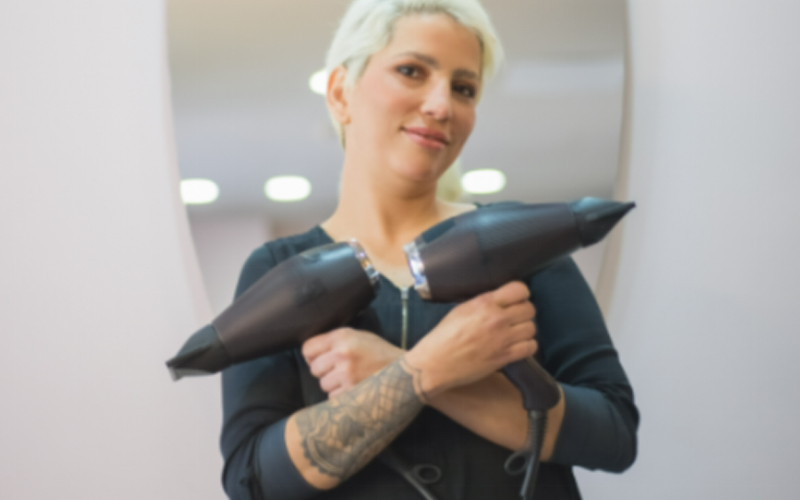In this article, we explore the potential uses and limitations of a hairdryer when compared to a heat gun, providing insights into whether this substitution is feasible for various applications.

While a hairdryer may not be an ideal substitute for a heat gun across all applications, it could potentially assist in tasks that require lower heat levels.
Examples of such tasks include peeling old stickers, removing dried glue, or thawing minor ice buildup.
However, the performance of a hairdryer as a heat gun alternative greatly depends on the demands of the task in question, and the outcome may not always be as desired.
Hairdryer Vs. Heat Gun: The Key Differences
Temperature Range
Hairdryers and heat guns differ significantly in their temperature ranges. Hairdryers typically have a maximum temperature of 140°F (60°C), which is suitable for hair styling and drying.
Heat guns, on the other hand, have a much wider temperature range, with some models capable of generating heat from 100°F to over 1,000°F (38°C to 537°C).
This makes heat guns more suitable for tasks that require higher temperatures, such as paint stripping, thawing pipes, or shrinking plastic wraps.
Air Flow
Another distinction between hairdryers and heat guns is their air flow capabilities.
Hairdryers are designed to produce a gentle and steady flow of warm air to safely dry and style hair.
The air flow is often adjustable to suit different hair types and styling needs.

Heat guns, in contrast, produce a much stronger and more focused stream of hot air intended for various DIY and professional applications.
The air flow in heat guns may also be adjustable, but it is generally meant to serve specific tasks rather than hair care.
Safety Features
Hairdryers are specifically designed for safe use on hair and scalp, incorporating safety features like multiple heat settings, cool shot options, and thermal protection to prevent overheating.
They also have a more ergonomic design for handling and may include concentrator nozzles or diffusers for specific styling needs.

Heat guns are not intended for use on hair or skin and lack the safety features found in hairdryers.
They can reach high temperatures that could cause severe burns if used improperly. As a result, heat guns should be handled with extreme caution and used only for their designated tasks.
Possible Uses of a Hairdryer as a Heat Gun
While heat guns typically provide higher temperatures and more powerful heat output, there are some instances where a hairdryer may be used as a substitute.
These projects might require lower heat settings or more precision to avoid damaging surfaces.
Embossing Crafts
For craft enthusiasts, embossing is a technique that creates raised designs on paper or other materials using heat.
A hairdryer can be useful in this case, as it provides a more gentle heat source suitable for delicate projects.
●When embossing with a hairdryer, hold the dryer about 4-6 inches away from the surface, ensuring the nozzle is focused on the embossing powder.
●Be patient and move the hairdryer slowly over the surface without concentrating heat on a single area for too long.
Keep in mind that using a hairdryer for embossing might take longer compared to a heat gun, as the temperature is significantly lower.
However, with proper care, you can still achieve beautiful results.
Stripping Paint
Stripping paint with a hairdryer is a slower and more delicate process than using a heat gun, but it can be done for small-scale projects.
The main advantage of using a hairdryer is its lower risk of scorching surfaces, making it a safer option for removing paint from delicate materials or surfaces.
To strip paint with a hairdryer, follow these steps:
1.Switch the hairdryer to its highest heat setting, but keep a safe distance from the surface to avoid burning or warping.
2.Direct the heat at the painted surface, focusing on a small section at a time.
3.As the paint softens, use a scraper to gently lift it away from the surface. Be sure to clean the scraper frequently for best results.
4.Repeat the process until you have removed all the paint from the desired area.
When using a hairdryer to strip paint, patience is key.
The process might be time-consuming, but it provides a safer and more controlled heat source for delicate projects.

Risks and Limitations
Melting Plastic
When using a hairdryer as a heat gun, one potential risk is the melting of plastic components on the hairdryer itself.
Hairdryers are not designed to withstand the high temperatures that heat guns can produce, and therefore, exposing them to prolonged heat could cause damage to the device.
Additionally, holding the hair dryer too close to materials, especially plastic items, may cause them to warp or melt due to the concentrated hot air.
Inadequate Heat
Another significant limitation of using a hairdryer instead of a heat gun is the lack of sufficient heat.
Hairdryers typically produce a maximum temperature of 140°F (60°C), which is insufficient for tasks that require higher levels of heat, such as paint stripping, welding plastics, or wood-burning.

Therefore, using a hair dryer for these purposes may not be effective and could lead to an incomplete or unsatisfactory result.
Prolonged Use
Lastly, using a hairdryer as a substitute for a heat gun may cause the device to overheat due to prolonged use.
Heat guns are designed to work for extended periods, whereas hair dryers could experience motor and coil damage when used for an extended time.
This could potentially shorten the lifespan of the hairdryer and compromise its effectiveness as a styling tool.
Overall, while a hairdryer can be an effective substitute for a heat gun in some cases, it is essential to be aware of the risks and limitations associated with using one for tasks beyond its design purpose.
Alternatives to Using a Hairdryer as a Heat Gun
While a hairdryer can be used as a substitute for a heat gun in some situations, it may not provide the desired results due to the lower temperature output (around 140°F) compared to a heat gun, which typically operates between 350°F to 1150°F.
In this section, we will explore the alternatives to using a hairdryer as a heat gun, such as purchasing an actual heat gun and exploring different DIY methods.
Purchasing an Actual Heat Gun
In many cases, it’s more efficient and effective to use a heat gun specifically designed for the task at hand, such as:
●Drying or removing paint from surfaces
●Defrosting a refrigerator
●Unfreezing locks and water pipes
Purchasing a heat gun ensures that you have the appropriate tool with the necessary temperature range for your needs, resulting in better performance and a safer experience.

Alternative DIY Methods
If you don’t want to invest in a heat gun and a hairdryer isn’t sufficient for your needs, there are alternative methods you can try, depending on the task:
1.Removing paint or adhesive: Try using a paint scraper, a putty knife, or even a credit card. You can also use a solvent like rubbing alcohol or white vinegar to soften the adhesive before scraping.
2.Defrosting a refrigerator: Unplug the refrigerator and leave the doors open to allow natural airflow to melt the ice. Be sure to place towels on the floor to absorb any melted water.
3.Unfreezing locks and water pipes: Apply heat using other methods, such as hot towels soaked in hot water, or a portable propane torch (with caution). Additionally, proper insulation and regular use of locks and faucets during freezing temperatures can help prevent future freezing issues.
By exploring these alternatives, you can find a suitable solution without relying on a hairdryer or purchasing a heat gun.
While these methods might require additional effort, they may offer more effective results based on the specific task at hand.
Conclusion
In summary, while a hair dryer can be used for certain tasks that require some heat application, it cannot entirely replace a heat gun due to its lower temperature capabilities.
Hair dryers typically reach a maximum temperature of around 140°F (60°C), whereas heat guns can achieve temperatures between 500-1200 degrees Fahrenheit.
A hair dryer might be useful for tasks such as peeling old stickers, removing dried glue, or defrosting frozen pipes or locks.
However, it is not ideal for jobs that involve stripping paint or welding plastics, as these tasks require the higher temperatures provided by a heat gun.
So using a hair dryer as a heat gun substitute should only be considered in situations where a lower temperature is sufficient for the task at hand.
For more demanding jobs, it is advisable to use a proper heat gun designed specifically for these purposes.
